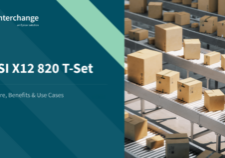The ANSI X12 EDI 862 T-Set: Structure, Benefits & Use Cases
The American National Standards Institute X12 (ANSI X12) plays a major role in Electronic Data Interchange (EDI), providing the framework for seamless and efficient business-to-business (B2B) communication.
In this article, we’re focusing on the ANSI X12 EDI 862 transaction set (T-set), a crucial component for businesses that require accurate and timely updates on shipment schedules. Understanding the significance, structure, and strategic application of the EDI 862 T-set is essential for businesses looking to optimise their EDI.
From outlining its core benefits to navigating its intricacies, we aim to provide a comprehensive exploration of this T-set, ensuring businesses are well-equipped to leverage its potential to the fullest.
Suggested reading: Bookmark our explainer of the ANSI X12 standard for more information on its various T-Sets and applications.
What is the ANSI X12 EDI 862 T-Set?
The ANSI X12 EDI 862 transaction set, commonly referred to as the Shipping Schedule, serves as a detailed communication tool between suppliers and buyers regarding the delivery of goods. It provides the means to convey precise shipping requirements, including specific dates and quantities, ensuring that all parties are aligned on the logistics.
Essentially, the EDI 862 T-set acts as a vital link in the supply chain management process, facilitating accurate and timely shipment updates. This ensures that both suppliers and buyers can maintain synchronised schedules, reducing the risk of delays and improving overall operational efficiency.
Key features of the ANSI X12 EDI 862 T-Set include:
- Real-time shipment data: Provides up-to-date information on shipment schedules, including any changes or updates.
- Detailed scheduling: Enables detailed specification of shipment dates, quantities, and locations.
- Automation: Reduces the need for manual updates and ensures accurate data transmission.
- Coordination: Enhances coordination between suppliers and buyers, improving supply chain efficiency.
By incorporating the EDI 862 into their operational frameworks, businesses can streamline their shipping processes, reduce the likelihood of errors, and ensure that deliveries are executed as planned. This transaction set is particularly beneficial for industries where timing and accuracy of shipments are critical to maintaining production schedules and meeting customer demand.
Common use cases for the ANSI X12 EDI 862 T-Set
The versatility of the ANSI X12 EDI 862 T-Set makes it invaluable across various industries, particularly those that rely on precise and timely shipment information. Here are some of the common use cases:
- Automotive industry: In the automotive sector, just-in-time (JIT) manufacturing processes require precise scheduling of parts and components. The EDI 862 T-Set helps manufacturers coordinate the delivery of parts to match production schedules, ensuring that assembly lines run smoothly without delays caused by missing components.
- Retail: For retail businesses, managing inventory levels and ensuring timely restocking are crucial. The EDI 862 T-Set allows retailers to communicate their shipping requirements to suppliers accurately, helping maintain optimal stock levels and preventing stock outs during peak seasons.
- Manufacturing: Manufacturers depend on the EDI 862 T-Set to schedule the delivery of raw materials and components. This ensures that production schedules are maintained without interruptions, thereby optimising operational efficiency and reducing downtime caused by material shortages.
- Healthcare: In the healthcare industry, the timely delivery of medical supplies and equipment is critical. The EDI 862 T-Set facilitates the scheduling of shipments to hospitals and clinics, ensuring that they receive the necessary supplies promptly to provide uninterrupted patient care.
- Food and beverage: Food and beverage companies use the EDI 862 T-Set to manage the delivery of perishable goods. Accurate scheduling of shipments ensures that products arrive fresh and within their shelf life, maintaining quality standards and reducing waste.
- E-commerce: E-commerce platforms rely on the EDI 862 T-Set to manage warehouse inventory and coordinate deliveries. By providing real-time updates on shipping schedules, the EDI 862 helps e-commerce businesses maintain accurate inventory levels and improve customer satisfaction by ensuring timely order fulfilment.
By integrating the EDI 862 into their supply chain operations, organisations in these sectors can achieve better visibility, coordination, and efficiency in their shipping processes. This not only enhances operational performance but also improves customer satisfaction by ensuring reliable and timely deliveries.
Example of an ANSI X12 EDI 862 T-Set
To provide a clearer understanding of how the ANSI X12 EDI 862 T-Set functions in practice, let’s look at a detailed example. This example will illustrate the structure of the transaction set and the type of information it conveys. By examining the segments within the T-Set, you can gain insight into how shipment schedules are communicated and managed electronically.
Here’s an example of what an ANSI X12 EDI 862 T-Set might look like:
| ST*862*0001~ BSS*00*123456*20240501*1234~ N1*SU*Supplier Name*92*12345~ N1*ST*Warehouse Name*92*67890~ LIN**BP*ABC123~ UIT*EA*100~ FST*50*EA*20240510~ FST*50*EA*20240515~ SHD*20240501*002~ CTT*2~SE*10*0001~ |
And here’s a breakdown of what each of those segments mean and represent:
| Segment | Example | Description |
| ST | ST8620001~ | Transaction Set Header: Indicates the start of the transaction set (862 for Shipping Schedule) and includes a control number for reference. |
| BSS | BSS00123456202405011234~ | Beginning Segment for Shipping Schedule: Provides identifying numbers and dates for the schedule. |
| N1 | N1SUSupplier Name9212345~ | Name (Supplier): Identifies the supplier by name and code. |
| N1 | N1STWarehouse Name9267890~ | Name (Ship To): Identifies the destination (e.g., warehouse) by name and code. |
| LIN | LIN**BP*ABC123~ | Item Identification: Specifies the item being shipped using a buyer’s part number. |
| UIT | UITEA100~ | Unit of Measurement: Defines the unit of measurement and the quantity (e.g., each and 100 units). |
| FST | FST50EA*20240510~ | Forecast Schedule: Specifies the quantity (50 units) and the date (10th May 2024) for the first shipment. |
| FST | FST50EA*20240515~ | Forecast Schedule: Specifies the quantity (50 units) and the date (15th May 2024) for the second shipment. |
| SHD | SHD20240501002~ | Shipping Date: Provides the shipment date and a specific delivery sequence number. |
| CTT | CTT*2~ | Transaction Totals: Indicates the total number of line items in the transaction. |
| SE | SE100001~ | Transaction Set Trailer: Ends the transaction set and includes the total number of segments and the control number. |
How is the ANSI X12 EDI 862 T-Set processed?
The processing of the ANSI X12 EDI 862 T-Set involves several steps, from the initial creation of the shipping schedule to the final receipt and action by the recipient. Understanding this workflow helps ensure that all parties can effectively manage and respond to shipment schedules. Below is a detailed breakdown of the typical workflow:
- Data collection: The process begins with the collection of relevant shipment data by the supplier. This includes information about the items to be shipped, quantities, and delivery dates.
- EDI 862 preparation: The collected shipment data is formatted into an EDI 862 document according to ANSI X12 standards. This includes filling out all required segments such as the shipment header, item details, and forecast schedules.
- Transmission: Once the EDI 862 document is prepared, it is transmitted to the intended recipient(s) using secure EDI communication protocols. This ensures the integrity and confidentiality of the data during transmission.
- Receipt and validation: Upon receipt, the recipient’s EDI system validates the document to ensure it is complete and conforms to the required standards. This step helps identify any errors or discrepancies that need to be addressed.
- Integration: After validation, the shipment data from the EDI 862 document is integrated into the recipient’s internal systems, such as warehouse management or inventory control systems. This integration allows the recipient to update their schedules and prepare for the incoming shipments.
- Action and response: Based on the shipment information, the recipient can take necessary actions such as adjusting inventory levels, planning warehouse space, or scheduling staff for unloading. If there are any issues or discrepancies, the recipient may send a response or acknowledgement back to the sender, such as an EDI 997 Functional Acknowledgement.
- Confirmation: In some cases, a confirmation of receipt and processing is sent back to the supplier. This may be in the form of an EDI 997 or another appropriate transaction set, confirming that the shipment schedule has been received and integrated.
What are the equivalents of the ANSI X12 EDI 862 T-Set in other standards?
The ANSI X12 EDI 862 T-Set has equivalents in various other Electronic Data Interchange (EDI) standards used across different regions and industries. These equivalents serve similar purposes in facilitating detailed communication about shipment schedules. Understanding these equivalents is crucial for businesses operating internationally or with partners using different EDI standards.
Here’s a table outlining the equivalents of the EDI 862 across different EDI standards:
| EDI Standard | Equivalent of ANSI X12 EDI 862 |
| EDIFACT | DELJIT (Delivery Just In Time) |
| TRADACOMS | CALSCHED (Call-Off Schedule) |
| ODETTE | DELINS (Delivery Instruction) |
| VDA | VDA 4915 (Delivery Instruction) |
Streamlining your supply chain with ANSI X12 EDI 862
From the automotive industry to healthcare, the EDI 862 T-Set provides a robust framework for managing timely deliveries and maintaining synchronised schedules. Its adoption facilitates better inventory management, optimises warehouse operations, and ensures that products reach their destinations without delay.
Understanding the structure and processing of the EDI 862, as well as recognising its equivalents in other standards, equips businesses with the knowledge to operate seamlessly across various platforms and international borders. This adaptability is crucial in today’s global market, where efficient and accurate data exchange can set you apart from the competition.
Ready to streamline your shipment scheduling and enhance your supply chain operations with the ANSI X12 EDI 862 T-Set? Contact our EDI experts today to get started and unlock the full potential of your EDI capabilities.



























































































































